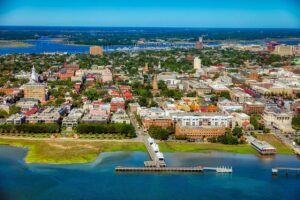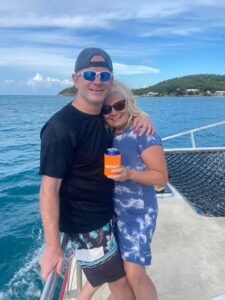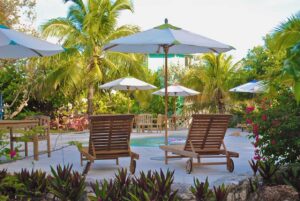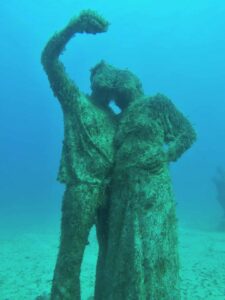One of the most extraordinary benefits of cruising in Maine is the unique opportunity to explore the thousands of magnificent islands that the glaciers abandoned when they retreated many eons ago.
Curtis Rindlaub, in the introduction of the cruisers’ bible A Cruising Guide to the Maine Coast, describes Maine this way: “On a chart, the coast of Maine is a Jackson Pollock painting. Rivers dribble to the sea, the coast is flung far with abandon, and the islands splatter the surface as if fallen from an overloaded brush.”
It’s the splattering of islands that can only be approached by boat that had great appeal to Peter and me during our short three-week cruise in Maine last summer. We believe Maine is best explored by water, experiencing the stunning beauty at every river turn or hidden harbor entrance, much the same way as our nation’s early explorers first experienced it.
We’d learned from previous trips that Maine’s vast coastline could not be explored in a lifetime, let alone three weeks, so on our second visit to Maine aboard our lobster cruising yacht Bee Weems, we narrowed our cruising area to the section between Portland and Mt. Desert Island. Our intention was to move at a slow pace and absorb the magic by seeking out the remote island anchorages that can only be explored by private boat. To help us along our way, we were armed with recommendations from fellow cruisers plus our two trusty guide books, the aforementioned A Cruising Guide to the Maine Coast and the Maine Island Trail Guide.
Our first anchorage, the Basin, a protected sanctuary on the New Meadows River, was highly recommended by a friend. The “bible” gave it a rating of four out of five stars. It was the perfect place to begin our Maine respite, completely sheltered, surrounded by evergreen trees, and with no signs of human life save the few sailboats anchored nearby. We took a collective deep breath, soaked in the natural beauty and released the tensions of our day-to-day life.
The following day we headed for Bath, but before leaving the New Meadows River we stopped to hike around Merritt Island, a small 28-acre wooded site with a loop trail. We would not have visited this island if I hadn’t studied the small spiral-bound book published annually by the Maine Island Trail Association (MITA) for its members. This useful guide offers descriptions and maps designating hiking trails and campsites for more than 200 islands along a 375-mile water route.
MITA is a nonprofit conservation organization formed in 1988 to provide a model of “thoughtful use and volunteer stewardship for the Maine Islands.” The supporting members of this group maintain a string of state-owned and private islands that are available to members and the public for overnight camping, picnicking and hiking. The number of islands under their stewardship has grown from 30 to 212 over their 27-year history.
About half the 3,000 islands dotting Maine’s coastline are owned by federal, state or conservation agencies. The other half are privately owned, but by acreage 94 percent are privately owned. Every island has its own fascinating story and they come in all shapes and sizes, from heavily wooded to massive granite slabs with no hints of plant life. Some were homesteaded, some became fishing communities or artists’ colonies, some were left alone to breeding bird colonies or clear-cut for wood.
In modern times, changes have occurred quickly and not always for the better. Conservation groups are doing their best to protect the islands and teach good stewardship. MITA is one of these groups, and I was eager to become a member to support their mission. As cruisers we have a great privilege and responsibility to be mindful of the impact we have on these storied treasures. A great way to show appreciation is to get to know the islands better. As with people, the more you make an effort to know them, the more you develop an appreciation for them and therefore the better you treat them.
The best way to learn about the islands is to talk to local Mainers, but it’s also helpful to read stories from conservation- group websites, blogs, cruising guides and the myriad of books written by those who want to share their love for these amazing natural wonders.
Merritt Island is owned by Bowdoin College and open to the public for hiking and camping in two locations during the summer months. Our exploration of this little gem was so much fun that it became my mission to plot our course from island to island with brief interludes at more conventional tourist attractions in between.
We continued south along the New Meadow River toward the ocean and eventually headed up the Kennebec River, stopping briefly in Bath to visit the Maine Maritime Museum. From Bath, we continued 22 miles west up the Kennebec.
Heading inland to find shelter from the high winds seemed wise, but the real reason for this out-of-the-way side trip was my intrigue with another island I discovered in the MITA cruising guide: Swan Island, originally named Swango or Island of the Eagles by the Native Americans, was so far up river that our electronic chart plotter had no charts for the area. Maybe that’s why we saw no other boats as we slowly meandered upstream. Swan Island’s initial appeal to me was its rich heritage as a Native American fishing village and stopover site for early explorers and historic figures such as John Smith, Benedict Arnold and Aaron Burr. In much the same way, today’s visitors arrive by kayak, canoe or via the small foot-passenger ferry that runs across the river to the small town of Richmond three times a day. The island is now owned and managed by the Maine Department of Inland Fisheries and Wildlife, and it’s also on the National Register of Historic Places.
We docked Bee Weems at the Richmond town landing and waited for the ferry to come across the short distance from the island to pick us up. Our young ferry captain was also the on-duty ranger in charge of assigning campsites and giving historic island tours. There were only three of us on the ferry, so this enthusiastic college student invited us to sit in the back of the pickup truck, the only wheeled vehicle on the island, as he drove to the other end and back, stopping along the way to let us get out and visit the old graveyard and the ruins of early dwellings. Grand vistas of rice paddies surrounded the island.
Annabella’s Bakery & Cafe, across the green from the town dock, was just the spot for a scrumptious breakfast before cruising back downstream toward Boothbay. The wind had subsided and the infamous fog swirled toward us as we approached the ocean. I lost all sense of time and space as we cautiously navigated the still grayness. I was melting into the wild beauty of the Maine coast. Unfortunately, my hopes of experiencing more island gems were squelched for several days as the fog swallowed them from sight.
We spent three days in Camden, waiting out the fog and making necessary boat repairs. When the fog finally dissipated we made a dash for the Barred Islands: Butter, Escargo and Bartender, all owned by the Cabot family. Our protected anchorage among this island grouping provided us with privacy and pristine beaches.
McGlathery Island was the culmination of our Maine-island wilderness exploration. Although the fog had returned, we didn’t want to pass it by because of its fabulous reputation. Beloved for its sheltered anchorages, sandy beaches, granite ledges, and wooded interior, McGlathery is one of the largest of the 30-plus granite islands that dot the seascape of Merchant Row. Its history is similar to that of many others: settled in the 1800s by a family that eventually succumbed to the harsh elements of year round living; bought by a sea captain for grazing sheep; eventually purchased by Friends of Nature, a conservation organization, to protect it from clear-cutting.
Washed-up lobster buoys and bits of line marked the walking trail that led us into the woodsy interior and then out again to a sandy beach flanked on each side by granite slabs. Through the fog I could hear the eerie sound of lobster boat engines so close to shore that I was sure they would come aground.
Making friends with just a few islands along the lengthy Maine Island Trail was a great way to develop an appreciation for all of them. And with this appreciation has come a desire to protect and defend their wild beauty so that others can enjoy them.
ITINERARY
1. Portland — DiMillo’s Old Port Marina
2. Freeport — Brewer South Freeport Marine
3. Anchorage — New Meadow River, The Basin
4. Anchorage — Merritt Island
5. Bath — Maine Maritime Museum
6. Richmond — Richmond Town Landing
7. Boothbay — Boothbay Harbor Marina
8. Camden — Lyman-Morse at Wayfarer Marine
9. Anchorage — The Barred Islands
10. Anchorage — Stonington
11. Anchorage — McGlathery Island





